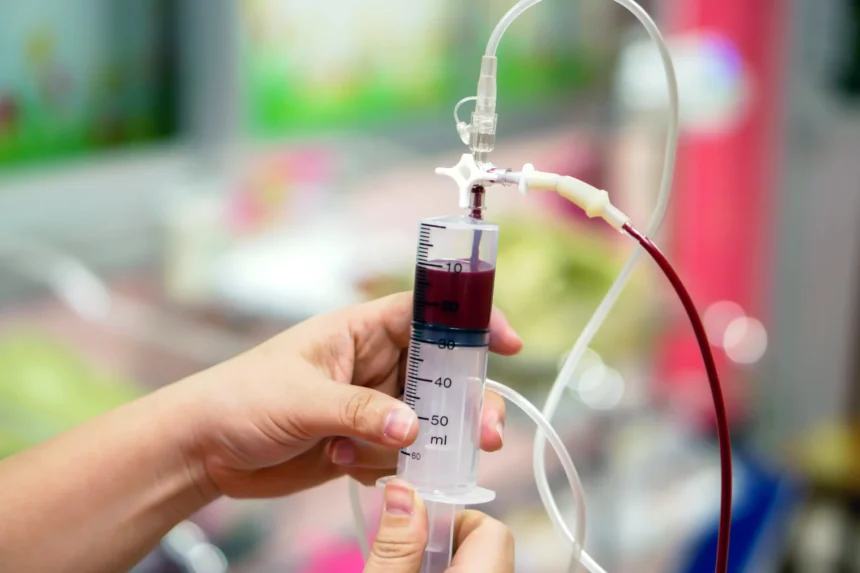Concerns about iron infusion side effects are common among individuals considering treatment for iron deficiency and anemia. Iron infusions offer a highly effective method to rapidly restore iron levels, but it is essential to understand both the potential benefits and the risks. In this comprehensive guide, we will answer your questions about infusions. We will walk you through the procedure, detail what you can expect during and after treatment, and outline the common side effects you may encounter.
What is an Iron Infusion?
An iron infusion is a medical treatment in which iron is delivered directly into your bloodstream through an intravenous (IV) line. A needle is used to insert a small tube into a vein, usually in your arm, and the iron solution is slowly dripped in, bypassing the digestive system.
This method is used to treat iron deficiency and the resulting anemia, particularly when other treatments have failed or are not suitable. Oral iron supplements are typically the first line of treatment, but they can be poorly absorbed, cause gastrointestinal side effects, or simply not work quickly enough. In these cases, an intravenous iron infusion offers a faster and more efficient way to replenish your body’s iron stores.
There are several types of iron preparations used for infusions, including iron sucrose, ferric carboxymaltose, and iron dextran. Your doctor will determine the best option based on the severity of your iron deficiency and your overall health.

Who Needs an Iron Infusion?
While oral iron supplements are generally the first step in treating iron deficiency, they are not always effective or well-tolerated. In such cases, an infusion may be recommended. Here are some situations in which iron infusion therapy might be the better option:
- Iron-Deficiency Anemia Unresponsive to Oral Iron: If you have iron deficiency anemia and have not improved with oral supplements, or if you experience significant side effects from them, an infusion may be more effective.
- Heavy Menstrual Bleeding: Women with consistently heavy periods can lose a substantial amount of iron, leading to deficiency. An infusion can quickly restore iron levels.
- Gastrointestinal Bleeding: Chronic blood loss in the digestive tract due to conditions like ulcers or polyps can necessitate infusions.
- Inflammatory Bowel Disease (IBD): Individuals with conditions such as Crohn’s disease or ulcerative colitis often struggle to absorb iron from food or oral supplements.
- Chronic Kidney Disease: This condition can impair the body’s ability to produce red blood cells and use iron efficiently.
- Certain Types of Cancer: Some cancers and their treatments may lead to iron deficiency and anemia.
- Pregnancy: In cases of severe iron deficiency during pregnancy, an iron infusion might be needed. This decision should always be made in consultation with your doctor.
- Post-Surgery: Significant blood loss from major surgery may require an iron infusion to quickly replenish iron stores.
Ultimately, whether you need an infusion will be determined by your doctor based on blood tests and a comprehensive assessment of your overall health.
Benefits of Iron Infusions
Iron infusions can be a real game-changer. By delivering iron straight into your bloodstream, this treatment bypasses the digestive system and rapidly boosts your iron levels. Many patients notice significant improvements after just one or a few sessions.
One major benefit is the rapid replenishment of iron stores. Unlike oral supplements that can take weeks or months to work, infusions restore your iron levels much faster. This is particularly helpful for individuals who have trouble absorbing iron due to conditions like Crohn’s disease or celiac disease.
Here are some of the key benefits of iron infusions:
- Enhanced Absorption: By bypassing the digestive system, the iron is directly available for your body to use, ensuring optimal uptake.
- Increased Energy Levels: Iron is essential for producing hemoglobin, the protein in red blood cells that carries oxygen. With boosted iron levels, you may experience less fatigue and more energy.
- Improved Cognitive Function: Adequate iron helps support brain function, which can lead to better concentration and memory.
- Relief from Anemia Symptoms: Many patients find that their shortness of breath, pale skin, brittle nails, and headaches improve as their iron deficiency is corrected.
Overall, infusions offer a fast and efficient way to correct iron deficiency and alleviate the various symptoms associated with anemia, making them a valuable option for those who need more than oral supplements can provide.
The Iron Infusion Procedure: What to Expect
Knowing what happens during a treatment can help ease any anxiety and prepare you for the experience. Here is a step-by-step overview of a typical iron infusion:
Pre-Infusion Assessment
Before the infusion begins, a healthcare professional will review your medical history, discuss any medications you’re taking, and likely order blood tests. This helps confirm your iron deficiency and determine the appropriate dosage for your treatment.
Setting
Iron infusions are usually administered in a medical facility such as a hospital, clinic, or a specialized infusion center. This controlled environment ensures that trained medical staff are available to monitor your progress throughout the procedure.
IV Line Insertion
A nurse or healthcare provider will insert a small, thin tube called a catheter into a vein, typically in your arm. This step is similar to having blood drawn and is necessary to deliver the iron solution directly into your bloodstream.
Infusion Process
Once the IV line is in place, the iron solution is slowly dripped into your bloodstream. The duration of the infusion depends on the type of iron preparation and the dosage prescribed; it can take anywhere from 15 minutes for some formulations to several hours for others.
Monitoring
During the infusion, a nurse will keep an eye on your vital signs such as blood pressure, heart rate, and breathing. They will also watch for any signs of a reaction, ensuring your safety throughout the treatment.
What You Might Feel
Most patients find the procedure relatively painless. You may notice a slight cooling sensation in your arm as the solution enters your vein, and some individuals report a mild metallic taste in their mouth. If you experience any discomfort or unusual sensations, it’s important to let the nurse know immediately.

Iron Infusion Side Effects: What You Need to Know
While infusions are generally safe and effective, it’s important to understand the potential iron infusion side effects. Most side effects are mild and temporary, but in rare cases, more serious reactions can occur. Being informed can help ensure a safe and positive experience.
Common and Mild Side Effects
Many people experience no side effects at all, or only minor ones. These may include:
- Metallic taste in the mouth: A temporary taste that can occur during or shortly after the infusion.
- Headache: Mild headaches are sometimes reported.
- Nausea and vomiting: Some individuals may feel mildly nauseous or, less frequently, experience vomiting.
- Muscle or joint pain: Temporary aches in muscles or joints can happen.
- Flushing: A feeling of warmth and slight redness in the face or skin.
- Injection site reactions: Pain, swelling, redness, or slight discoloration at the site where the infusion was administered.
These mild side effects typically resolve on their own within a day or two.
Less Common but More Serious Side Effects
Serious iron infusion side effects are rare but require immediate medical attention. Contact your healthcare provider if you experience any of the following:
- Allergic reaction: Look out for signs such as itching, rash, hives, swelling of the face, lips, or tongue, difficulty breathing, or wheezing.
- Hypotension (low blood pressure): Symptoms like dizziness, lightheadedness, or fainting.
- Hypertension (high blood pressure): Severe headache or blurred vision may occur.
- Dizziness or fainting
- Chest pain
These reactions are uncommon but demand prompt intervention.
Long-Term Side Effects
With repeated iron infusions, there is a small risk of developing iron overload (hemochromatosis), a condition where the body stores too much iron. This is rare when infusions are monitored regularly with blood tests. Your doctor will track your iron levels to minimize this risk.
What to Do If You Experience Side Effects
- Mild Side Effects: They usually go away on their own. Stay hydrated, rest, and do not hesitate to contact your nurse or doctor for reassurance if needed.
- Serious Side Effects: Seek immediate medical attention if you experience any severe reactions.
Maintaining open communication with your healthcare provider throughout the process is essential. Always report any iron infusion side effects you experience, no matter how minor they may seem, so that your treatment can be adjusted if necessary.
Frequently Asked Questions (FAQs)
Can I Get One During Pregnancy?
Iron deficiency is common during pregnancy, and sometimes oral supplements do not provide enough relief. IV iron is an option for pregnant women, but it must be administered under strict medical supervision. The decision to use this treatment depends on the severity of the deficiency, the trimester, and the balance of potential risks and benefits.
How Long Does the Procedure Take?
The duration of an iron infusion varies depending on the type of iron preparation and the prescribed dosage. Some infusions can be completed in as little as 15 minutes, while others may take several hours. Your healthcare provider will advise you on the expected time frame for your specific treatment.
What Are the Signs That I Need IV Iron?
If you have iron deficiency anemia, you might notice symptoms such as:
- Persistent fatigue and weakness
- Pale skin
- Shortness of breath
- Headaches or dizziness
- Brittle nails
- Cold hands and feet
Since these symptoms can also be caused by other conditions, a blood test to measure ferritin levels (iron stores) and hemoglobin is necessary. Your doctor will then determine whether oral iron is sufficient or if an infusion is warranted.
How Often Will I Need Them?
The frequency of iron infusions depends on the underlying cause of your deficiency and how well you respond to treatment. Some patients may need only a single infusion, while others require periodic treatments to maintain healthy iron levels. Your doctor will monitor your levels and set an appropriate schedule.
How Do I Prepare for an Infusion?
Preparation is usually minimal. Your healthcare provider will give you specific instructions, but generally you can eat and drink normally before the procedure. It is advisable to wear comfortable clothing with easy access to your arm and to inform your doctor about any medications or supplements you are taking.
Are There Any Alternatives to an Infusion?
Yes, the primary alternative is oral iron supplementation, which is often the first line of treatment. In some cases, dietary changes to boost your iron intake may also be beneficial.
What Are the Most Common Iron Infusion Side Effects?
While serious reactions are rare, some patients experience mild side effects, such as:
- A temporary metallic taste in the mouth
- Headaches
- Flushing
These symptoms usually resolve on their own. If you notice any significant or unusual reactions, contact your doctor immediately.






